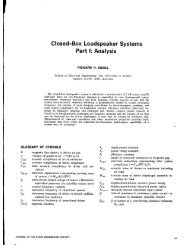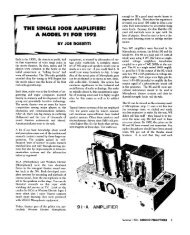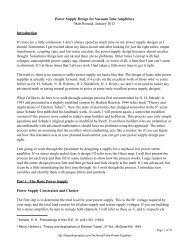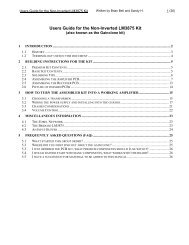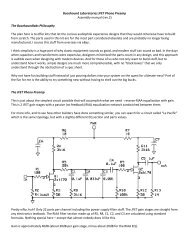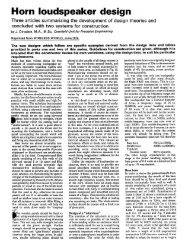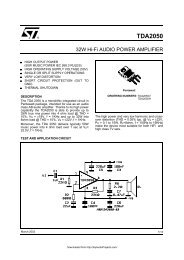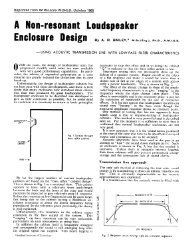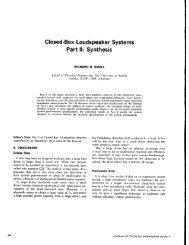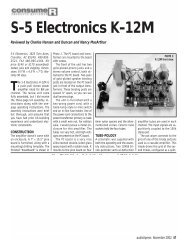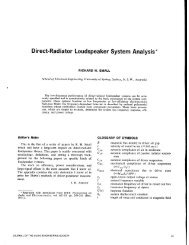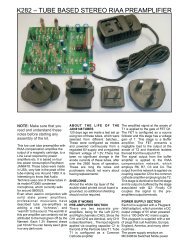A Model of Open-Baffle Loudspeakers - DIY Audio Projects
A Model of Open-Baffle Loudspeakers - DIY Audio Projects
A Model of Open-Baffle Loudspeakers - DIY Audio Projects
You also want an ePaper? Increase the reach of your titles
YUMPU automatically turns print PDFs into web optimized ePapers that Google loves.
Figure 5. Schematic representation <strong>of</strong> multiple scattering. Thick solid line = first sound from driver<br />
to edge; solid thin line = second-order scattering; dashed line = third-order scattering.<br />
Although the multiple scattering process can be from signal processing point <strong>of</strong> view regarded to be<br />
an IIR filter, representing it as a conventional filter will result in a rather complex and thus memoryconsuming<br />
network. An alternative way is to represent the signal an edge point as a polynomial <strong>of</strong> z-<br />
’ and to use a matrix representation for the multiple scattering:<br />
Equation 10<br />
Pl<br />
P2<br />
a1,2 ’ a3,2 a 42<br />
P3 = al,3 a2,3 0 an,3<br />
.<br />
. .<br />
. . .<br />
P n-N+1 Ul,tl a2,n a34 *** 0<br />
Pl<br />
P2<br />
P3<br />
PVl<br />
where N is the order <strong>of</strong> scattering; N = 1 is the first sound arriving from the driver to the edge point.<br />
Each matrix element a,, consists <strong>of</strong> a real coefficient representing the scattering amplitude from<br />
point i toj and an exponential z-~(‘~)“, where D(ij) is the distance between the points. In practice the<br />
distance (divided by c) can be truncated to the closest integer value to keep the computation simple.<br />
If the baffle has straight edges, then the scattering coefficient between any points on the same edge<br />
is zero. The multiple scattering matrix is independent <strong>of</strong> the driver size or position.<br />
The multiplication <strong>of</strong> the vector consisting <strong>of</strong> the polynomials by the matrix resembles the<br />
convolution <strong>of</strong> the two; the delays represented matrix, however, are not uniformly spaced or<br />
consecutively ordered in each column. Each multiplication corresponds to an operation <strong>of</strong> delaying<br />
and attenuating the sample. The operation could be turned into a proper convolution by arranging<br />
each column <strong>of</strong> the matrix by the power <strong>of</strong> z-‘, merging elements corresponding to the same power<br />
and writing the result as an impulse response.<br />
Each scattering naturally lengthens the impulse response. The number <strong>of</strong> samples added can be<br />
estimated simply from the maximum dimension <strong>of</strong> the baffle. For a 1 * 1 m2 baffle the length <strong>of</strong> the<br />
diagonal is about 1.4 m, which at 100 kHz sampling rate equals about 412 samples. Thus, after 5<br />
scatterings the original impulse response is lengthened only about by 2000 samples.



